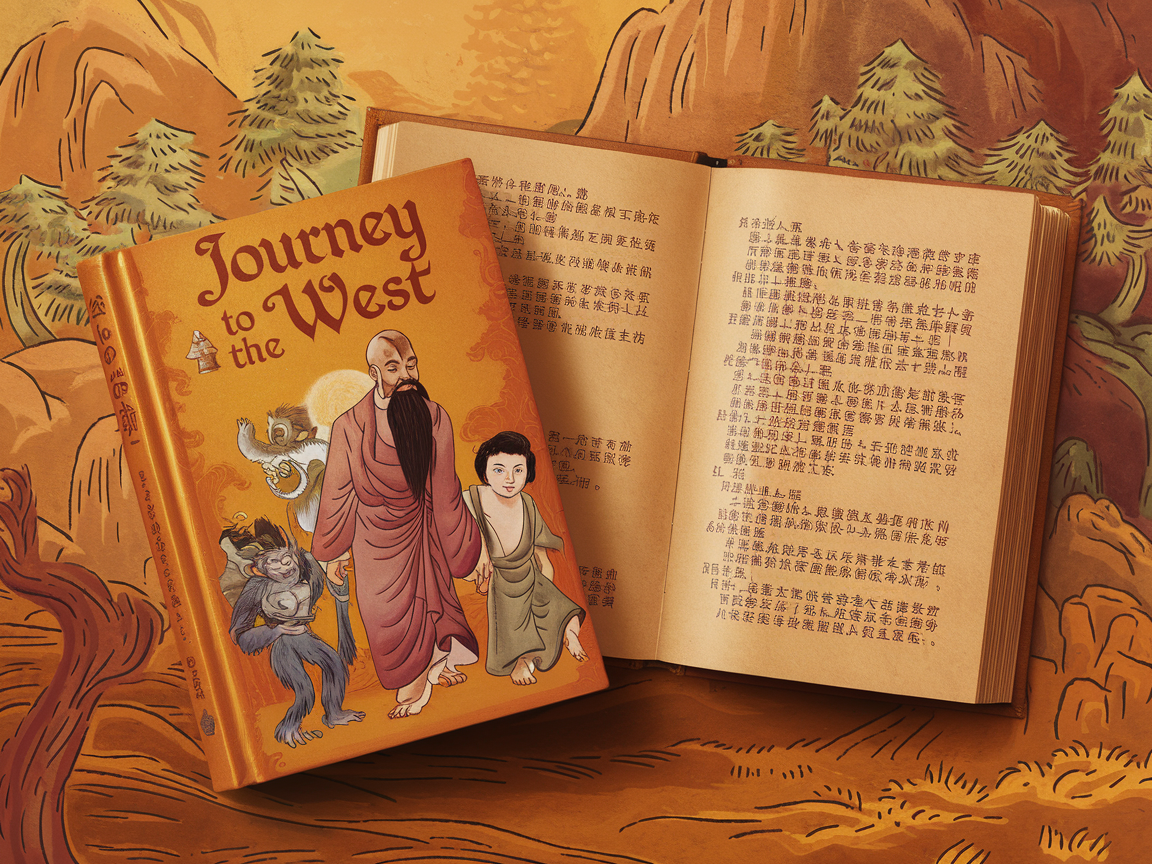Introduction to Journey to the West
‘Journey to the West‘, written by Wu Cheng’en in the 16th century, stands as one of the Four Great Classical Novels of Chinese literature. Composed during the Ming dynasty, this epic tale offers a blend of myth, folklore, and spirituality. Its roots lie in historical records of the pilgrimage of the Buddhist monk Xuanzang, who traveled from China to India in the quest for sacred scriptures. Over time, Xuanzang’s arduous journey was transformed into a fantastical narrative, encapsulating the essence of adventure, religion, and moral lessons.
The initial publication of ‘Journey to the West’ brought to life a narrative that intricately woven details of belief systems, mythical creatures, and moral allegories. Wu Cheng’en’s work was groundbreaking, providing not only entertainment but also philosophical insights and spiritual guidance. The novel’s impact extends far beyond its entertainment value, delving into themes of perseverance, enlightenment, and the battle between good and evil.
Recognized for its literary significance, ‘Journey to the West’ was gradually translated into various languages, facilitating its introduction to a global audience. The translations, while respecting the cultural ethos and preserving the authenticity of the original text, made this masterpiece accessible to readers worldwide, thereby amplifying its reach and influence. The novel’s characters—such as the monk Xuanzang, the Monkey King (Sun Wukong), Pigsy, and Sandy—have become cultural icons, symbolizing various archetypes still relevant in contemporary interpretations of East Asian culture.
Its influence permeates through various art forms, from literature and theatre to television and film, solidifying its status as a foundational pillar of East Asian cultural heritage. Through its blend of adventure, spiritual quests, and moral lessons, ‘Journey to the West’ continues to enchant readers and provide invaluable insights into Chinese cultural and literary traditions.
This enduring relevance and profound cultural impact underline the timeless nature of ‘Journey to the West’, setting the stage for a detailed exploration of the novel’s many facets in the sections that follow.

Plot Overview and Main Characters of Journey to the West
‘Journey to the West’ is an epic Chinese novel that takes readers on an adventurous quest steeped in spiritual themes and mythical narratives. The central storyline revolves around the Buddhist monk Tang Sanzang, who embarks on an arduous pilgrimage from China to India to obtain sacred Buddhist scriptures to foster enlightenment and salvation.
Central to the narrative are Tang Sanzang’s disciples, each of whom plays a crucial role in the journey’s progression. Sun Wukong, known widely as the Monkey King, stands out as the most dynamic character. Born from a magical stone, Sun Wukong possesses extraordinary strength, magical abilities, and a rebellious spirit. His journey from a havoc-wreaking demon to a devout disciple encapsulates significant themes of redemption and transformation.
Accompanying them is Zhu Bajie, often referred to as Pigsy. A former celestial general, Zhu Bajie was banished to the mortal world for his misdeeds. Characterized by his gluttonous and lustful inclinations, Pigsy’s comedic yet complex personality adds layers to the story, highlighting the struggles between virtue and vice.
Then there is Sha Wujing, or Sandy, a river ogre who, after being disciplined for his wrongful actions in heaven, chooses to atone by assisting Tang Sanzang. Unlike his more ostentatious counterparts, Sha Wujing represents loyalty and perseverance, embodying the quiet strength necessary to navigate the journey’s challenges.
Rounding out the eclectic group is the White Dragon Horse. Initially a dragon prince who erred in heaven, he transforms into a loyal steed to serve Tang Sanzang. While he doesn’t engage in the battle scenes as much as the others, his presence is indispensable for their travels.
Together, these characters face numerous trials and tribulations, battling demons and internal conflicts. Their enduring bond and varied capabilities reflect the novel’s broader existential and moral inquiries, making ‘Journey to the West’ a rich tapestry of adventure and allegory. This journey captures the essence of human experience, blending fantastical elements with profound philosophical insights.

Themes and Symbolism
‘Journey to the West’ is a rich tapestry of themes and symbolic elements that resonate deeply within Chinese culture and philosophy. One of the most prominent themes is the perennial struggle between good and evil. This epic journey, led by the monk Xuanzang and his eclectic group of companions, serves as a microcosm for the ongoing battle between virtuous endeavors and malevolent forces. Each character’s quest is marked by trials that test their moral resolve, exemplifying the relentless contest between enlightenment and temptation.
Another crucial theme is the importance of faith and perseverance. The journey itself is a test of spiritual and psychological endurance. Xuanzang’s unwavering faith is continually tested by the myriad of obstacles and demonic adversaries that lie in wait. His dedication to his quest symbolizes the human capacity to overcome insurmountable odds through steadfast belief and unyielding perseverance. This theme underscores the novel’s didactic purpose, instilling the value of unwavering commitment in the face of adversity.
The journey of self-discovery and transformation is also central to the narrative. Each character undergoes significant personal growth, often catalyzed by their collective experiences. For instance, Sun Wukong, the Monkey King, transforms from a rebellious and impetuous figure into a disciplined and conscientious protector. This transformation exemplifies the broader philosophical ideal of self-improvement and enlightenment through introspection and experience.
The symbolism within ‘Journey to the West’ further enriches its narrative complexity. The characters themselves are often allegorical, representing various aspects of human nature and spirituality. Sun Wukong signifies unrestrained freedom and the power of the mind, while Xuanzang embodies purity and the pursuit of spiritual elevation. Their adventures symbolize broader philosophical concepts such as the Taoist journey towards harmony and the Buddhist path to enlightenment.
Through these layers of themes and symbolism, ‘Journey to the West’ not only engages readers with its adventurous plot but also imparts profound insights into the spiritual and philosophical ideals that permeate Chinese culture. Understanding these deeper meanings allows readers to fully appreciate the timeless relevance and enduring legacy of this classic work.

Legacy and Influence in Modern Culture
“Journey to the West” remains a cornerstone of Chinese literature and mythology, boasting an enduring legacy that permeates various facets of modern culture. Originally written during the Ming Dynasty, this classic tale continues to inspire countless adaptations and reinterpretations across different media, showcasing its timelessness and universal appeal.
In literature, “Journey to the West” has been revisited and reimagined in numerous novels and scholarly works. Its rich narrative and mythological depth have made it a popular subject in academic studies, where it is analyzed for its literary merits and its reflections on Chinese cultural and religious traditions. Through these academic lenses, the novel’s themes and characters, particularly the indomitable Monkey King, have been explored in-depth, influencing modern interpretations of Chinese folklore.
The influence of “Journey to the West” extends significantly into television and film. The tale has been adapted into live-action series and movies, some achieving cult status. For instance, the 1986 Chinese TV series “Journey to the West” remains a beloved classic, while recent adaptations such as “The Monkey King” film series have brought the story to new generations. These productions not only highlight the novel’s dynamic storytelling but also bring to life its fantastical elements with modern cinematic techniques.
Animation and video games have also tapped into the novel’s vibrant world, offering fresh perspectives and engaging experiences. Animated series like “Dragon Ball” and video games such as “Enslaved: Odyssey to the West” are inspired by the epic’s characters and plotlines, further attesting to its widespread appeal. These adaptations often introduce “Journey to the West” to international audiences, broadening its influence beyond Chinese borders.
In essence, “Journey to the West” has left an indelible mark on global culture, seamlessly woven into the fabric of modern entertainment and scholarly discourse. Its ability to adapt and resonate with diverse audiences underscores its lasting relevance, affirming its status as a timeless classic.
GET IN NOW






I did not speak it.
——
https://hosting.estate/tags/%D1%85%D0%BE%D1%81%D1%82%D0%B8%D0%BD%D0%B3%20%D1%81%20%D0%BA%D0%B0%D1%81%D1%82%D0%BE%D0%BC%D0%BD%D0%BE%D0%B9%20%D0%BF%D0%B0%D0%BD%D0%B5%D0%BB%D1%8C%D1%8E/